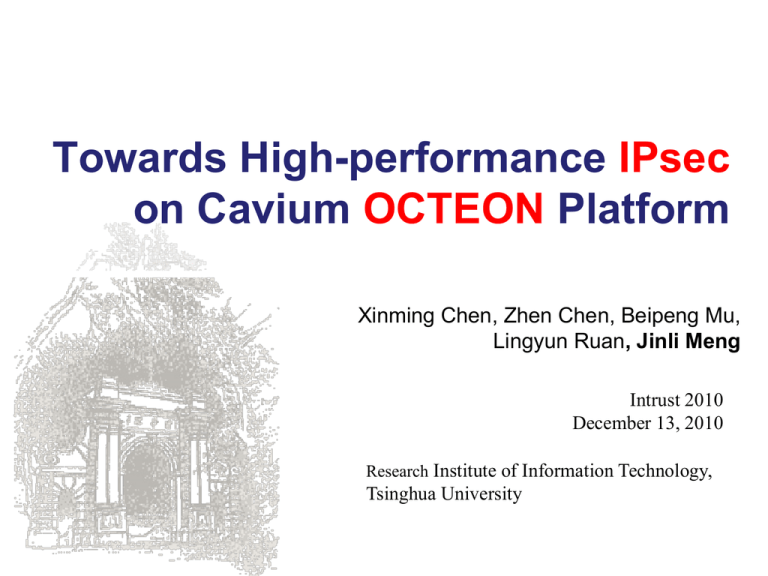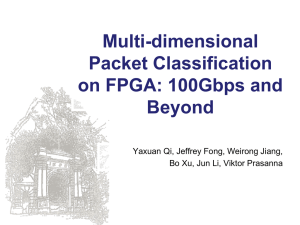Cavium-IPsec
advertisement

Towards High-performance IPsec on Cavium OCTEON Platform Xinming Chen, Zhen Chen, Beipeng Mu, Lingyun Ruan, Jinli Meng Intrust 2010 December 13, 2010 Research Institute of Information Technology, Tsinghua University Outline About us Background Implementation Experiment and Performance Conclusion NSLab, RIIT, Tsinghua Univ Our Lab Network Security Lab (NSLab) belongs to the Research Institute of Information Technology (RIIT), Tsinghua Univ. http://security.riit.tsinghua.edu.cn/wiki/NSLab Research Area Network security algorithmics Network processor architecture and parallel processing P2P overlay network routing and network coding NSLab, RIIT, Tsinghua Univ Our Recent Projects 20 Gbps Security Gateway 100 Gbps Network Algorithms National 863 Project Packet classification Pattern matching Datacenter Networks Distributed Security Architecture Central Control Management NSLab, RIIT, Tsinghua Univ Our Recent Publication Yaxuan Qi, Kai Wang, Jeffrey Fong, Weirong Jiang, Yibo Xue, Jun Li and Viktor Prasanna, FEACAN: Front-End Acceleration for Content-Aware Network Processing, the 30th IEEE INFOCOM, 2011. Yaxuan Qi, Zongwei Zhou, Yiyao Wu, Yibo Xue and Jun Li, Towards Highperformance Pattern Matching on Multi-core Network Processing Platforms, Proc. of GLOBECOM, 2010. Fei He, Yaxuan Qi, Yibo Xue and Jun Li, YACA: Yet Another Cluster-based Architecture for Network Intrusion Prevention, Proc. of IEEE GLOBECOM 2010. Yaxuan Qi, Lianghong Xu, Baohua Yang, Yibo Xue, and Jun Li, Packet Classification Algorithms: From Theory to Practice, Proc. of the 28th IEEE INFOCOM, 2009. Tian Song, Wei Zhang, Dongsheng Wang, and Yibo Xue, Memory Efficient Multiple Pattern Matching Architecture for Network Security, Proc. of the 27th IEEE INFOCOM, 2008. Bo Xu, Yaxuan Qi, Fei He, Zongwei Zhou, Yibo Xue, and Jun Li, Fast Path Session Creation on Network Processors, Proc. of ICDCS, 2008. Yaxuan Qi, Bo Xu, Fei He, Baohua Yang, Jianming Yu, and Jun Li, Towards High-performance Flow-level Packet Processing on Multi-core Network Processors, Proc. of the ACM/IEEE Symposium on Architectures for Networking and Communications Systems (ANCS), 2007. NSLab, RIIT, Tsinghua Univ Our Team NSLab, RIIT, Tsinghua Univ Outline About us Background Implementation Experiment and Performance Conclusion NSLab, RIIT, Tsinghua Univ Motivation Problem: Internet’s openness brings security risks Solution: Security mechanisms supply confidentiality, data integrity, anti-replay attack, etc. But, In fact: 10% of Internet Info. are protected Reason: Security mechanisms reduce Quality of Performance, bring additional Cost and Payload Our goal: efficient and high-performance parameters selection and implementation to protect more info. across the Internet NSLab, RIIT, Tsinghua Univ Outline About us Background Implementation Experiment and Performance Conclusion NSLab, RIIT, Tsinghua Univ Implementation Hardware Platform: Cavium OCTEON Security mechanism: IPsec NSLab, RIIT, Tsinghua Univ Cavium OCTEON NP: Hardware acceleration of packet processing and encrypting (micro instructions) NSLab, RIIT, Tsinghua Univ Mechanisms Run-to-completion Execute the whole processing of a flow in the same core Pipeline Divide the processing procedure of packet into several simple executives or stages, and one stage in one core. Multiple cores can deal with packets in different stage from the same flow simultaneously. While the completion of one packet processing needs multiple cores. NSLab, RIIT, Tsinghua Univ State of work flow NSLab, RIIT, Tsinghua Univ IPsec Add security fields between IP field and transport layer NSLab, RIIT, Tsinghua Univ States of IPsec work flow Defragment: reconstruct IP packet with data fragment. IPsec decrypt: decrypt the incoming packets and recover to the original ones. Lookup: while forwarding the packet, it needs to check the SPD table and SA table according to the hash value of fivetuple of the packet. Process: the necessary processing of packets before sending them out, such as NAT translation or TCP sequence number adjustment. IPsec encrypt: encrypt the output packets. Output: places the packet into an output queue and let Tx driver sent it out. NSLab, RIIT, Tsinghua Univ Outline About us Background Implementation Experiment and Performance Conclusion NSLab, RIIT, Tsinghua Univ Parameters Algorithms: AES, DES, 3DES Packet length: 64 bytes ~ 1280 bytes Core numbers: 1~16 System mechanisms: Pipeline vs Run-tocompletion NSLab, RIIT, Tsinghua Univ Test Environments DPB: data processing block Agilent N2X: multi-service test solution NSLab, RIIT, Tsinghua Univ Different Algorithms and Packet Length NSLab, RIIT, Tsinghua Univ Different core numbers NSLab, RIIT, Tsinghua Univ Pipeline and Run-to-completion NSLab, RIIT, Tsinghua Univ Outline About us Background Implementation Experiment and Performance Conclusion NSLab, RIIT, Tsinghua Univ Conclusion On Cavium OCTEON CN58XX Algorithms: AES128 Packet length: the longer the better Core numbers: the more the better Mechanism: Pipeline is better than Run-tocompletion Why? NSLab, RIIT, Tsinghua Univ Algorithms AES speed is almost the same as DES speed in hardware implementation Smaller key makes higher processing speed NSLab, RIIT, Tsinghua Univ Packet length The work for processing each packet is fixed The longer the packet length is =>The less the processed packets during a certain period are =>The smaller the factor of processing time is =>The larger the processing speed is =>The better the performance is NSLab, RIIT, Tsinghua Univ Core number Without any interaction between the cores The throughput is linear to the core number NSLab, RIIT, Tsinghua Univ Mechanism Mechanism Pipeline Run-to-completion when access critical region Quite and Deschedule May be blocked Cache hit-rate Locality, high low NSLab, RIIT, Tsinghua Univ Future work Comparison with other NP and security mechanisms General standard mechanisms of encrypting the Internet NSLab, RIIT, Tsinghua Univ Q&A Thank you for your listening! NSLab, RIIT, Tsinghua Univ







